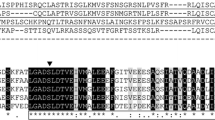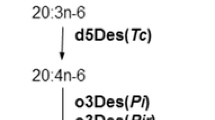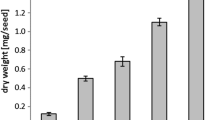Abstract.
Two high-palmitic acid sunflower (Helianthus annuus L.) mutants, CAS-5 and CAS-12, have been biochemically characterised. The enzymatic activities found to be responsible for the mutant characteristics are β-keto-acyl-acyl carrier protein synthetase II (KASII; EC 2.3.1.41) and acyl-acyl carrier protein thioesterase (EC 3.1.2.14). Our data suggest that the high-palmitic acid phenotype observed in both mutant lines is due to the combined effect of a lower KASII activity and a higher thioesterase activity with respect to palmitoyl-acyl carrier protein (16:0-ACP). The level of the latter enzyme appeared to be insufficient to hydrolyse the produced 16:0-ACP completely. As a consequence of this, three new fatty acids appear: palmitoleic acid (16:1 Δ9), asclepic acid (18:1 Δ11), and palmitolinoleic acid (16:2 Δ9 Δ12). These fatty acids should be synthesised from palmitoyl-ACP or a derivative by the action of the stearoyl-ACP desaturase, fatty acid synthetase II and oleoyl-phosphatidylcholine desaturase, respectively.
Similar content being viewed by others
Author information
Authors and Affiliations
Additional information
Received: 11 July 1998 / Accepted: 10 October 1998
Rights and permissions
About this article
Cite this article
Martínez-Force, E., Álvarez-Ortega, R. & Garcés, R. Enzymatic characterisation of high-palmitic acid sunflower (Helianthus annuus L.) mutants. Planta 207, 533–538 (1999). https://doi.org/10.1007/s004250050514
Issue Date:
DOI: https://doi.org/10.1007/s004250050514




